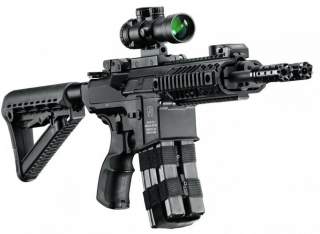Meet Israel’s Deadly Gilboa DBR Snake AR-Type Rifle (It Can Fire Two Bullets Simultaneously)
Good idea or a waste of time?
Is this really a good idea?
The Israeli company Silver Shadow recently attracted attention for its double-barreled AR-type rifle, the Gilboa DBR Snake. For the most part, it’s an AR, uses AR parts and fires the 5.56-millimeter AR round. Except that it has two separate barrels, two magazines and two ejection ports — with two triggers as if two AR rifles had smashed into each other.
The two triggers are to make the Snake legal for civilian use in the United States, as We Are the Mighty‘s Blake Stilwell noted, citing ATF regulations for machine guns. But it’s easy enough to pull both, firing two rounds at once.
(This first appeared last year.)
It’s the civilian market, primarily in America, where this gun should find buyers. Military customers are highly unlikely to view this rifle as very practical.
But let’s back up for a moment. The U.S. military has studied double-barreled semi-automatic rifles for potential combat use before. The Pentagon’s Project Salvo, which began in 1951, aimed to produce a next-generation infantry rifle suitable for modern warfare while embodying the lessons of World War II.
One of these lessons is the importance of what the military calls “fire superiority” — shooting more bullets at the enemy, accurately, than he is shooting back at you. If you have fire superiority, the sheer volume of fire limits an enemy’s room to maneuver, pinning them down and making them easier to attack on their exposed flanks. Heavy fire can also inflict casualties through shrapnel and ricochet.
Ultimately, Project Salvo led to the AR series of rifles and its first military adaptation, the selective-fire M-16, with semi-automatic, three-round burst and fully-automatic modes.
There were several far-flung concepts put into development testing as part of Project Salvo. There was a flechette-firing shotgun — never adopted — designed to shred enemy soldiers with dozens of darts. Project Salvo also involved experiments with double-barreled rifles including the 5.56-millimeter Winchester Salvo, produced in 1957.
The Winchester Salvo, like the modern Snake, has two ejection ports with one on each side of the receiver. (That’s a lot of flying brass.) There are two magazines, and the rifle’s unloaded weight comes to 11.8 pounds. It’s difficult to compare the weight to a modern AR rifle given the wide variety of variants and their accessories, but the Salvo is a few pounds heavier than an “average” AR.
The G3, a heavy NATO battle rifle from the Cold War, weighs nine pounds — about as much as a Gilboa DBR Snake. That makes the Snake a bit on the heavy side, but not unreasonable.
One problem with the Winchester Salvo came with its 5.56-millimeter cartridge — an unusual and experimental duplex cartridge which carried two bullets, one behind the other, for four total bullets firing every time the shooter pulled the trigger. This added recoil — too much of it.
The Snake doesn’t use duplex ammunition, but it faces a same basic questions of efficiency, weight and waste. Ammunition adds weight, yet two bullets traveling side-by-side are still traveling toward the same target. The enemy will likely not know the difference from a standard, single-barrel AR as the rounds snap around them.
The result is twice the ammunition, and cost, for a similar suppressive effect. Better to have a lightweight rifle — with a single barrel. And if soldiers need extra firepower, they can always flip the selector switch to a three-round burst.
This first appeared in WarIsBoring here.


